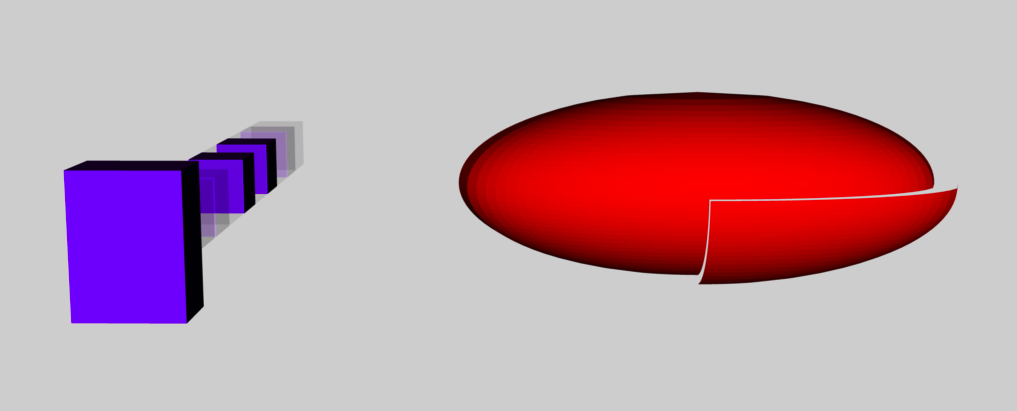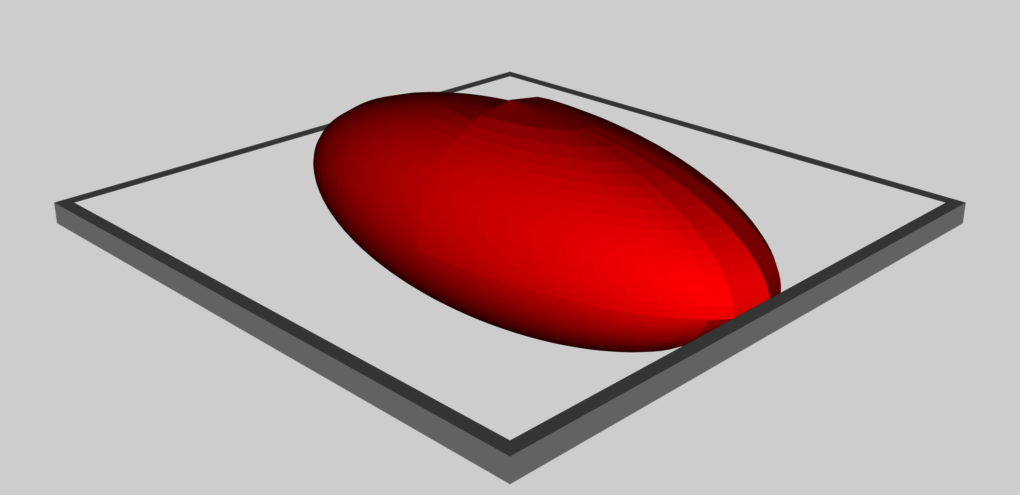User:Tohline/Appendix/Ramblings/RiemannMeetsOculus
Rebuild Riemann S-Type Ellipsoid Inside Oculus Rift S Environment

|
|---|
| | Tiled Menu | Tables of Content | Banner Video | Tohline Home Page | |
Preamble
In an accompanying discussion, we have illustrated how an animated, interactive 3D scene can be largely defined via the xml-formatted language named COLLADA. In the last major subsection of that discussion, we have outlined the steps that can be followed to specifically generate any of a variety of Riemann S-Type ellipsoids. These steps were identified within the context of our effort to construct 3D VR/AR models that could be faithfully rendered using the Mac's Preview app.
In a separate but closely connected discussion, we have demonstrated that most of our COLLADA-based models can be imported into the 3D virtual-reality environment of the Oculus Rift S. Toward the end of this separate discussion, we provide the full COLLADA code — in a plain text format — along with a summary description of a model that has been assigned the name, FullLast45X.dae.
Intially, we discovered that most of the Riemann S-Type ellipsoids that we developed while relying on the Mac's Preview app did not display properly within the Oculus Rift S environment. What we propose to do, here, is methodically re-construct a variety of our earlier models that were viewable in the "Preview" app in such a way that they are all viewable with the Oculus Rift S. We begin with this "… 45X" model — renaming it, RiemannBuild00.dae. Step by step we will insert components of one of our previously constructed COLLADA-based models of an S-Type Riemann ellipsoid into a <visual_scene> that can be properly executed within the Oculus Rift S.
Assemble Components
-
RiemannBuild00.dae:
- This model, with <up_axis>Z_UP></up_axis>, contains a set of purple cubes that lie in the Y0-Z0 plane, and along the inertial frame's X0 axis from -5.0 inches to +5.0 inches; the last purple "cube" (at X0 = +5) is actually a rectangular box whose longest axis is parallel to the Z0 axis.
Mac Preview of RiemannBuild00.dae 
- The scene also includes a red ellipsoid with axis ratios b/a = 0.41 and c/a = 0.385. The "EntireEllipsoid" has been scaled such that its longest ( c ) axis has a length of 4 inches; and it has been translated in the Y0-Z0 plane to a location along the Y0 axis where the center of the ellipsoid is 8.0 inches from the origin of the inertial coordinate system. The ellipsoid's "First" quadrant <node> was, in addition, scaled by (1.1, 1.1, 1.1) in order for it to stick out a bit from the other quadrants to help the viewer decipher its rotational behavior.
<node id="EntireEllipsoid" name="OculusRift_EFE"> <translate>0.0 8.0 0.0</translate> <rotate sid="rotationY">0.0 1.0 0.0 90.0</rotate> <rotate sid="rotationZ">0.0 0.0 1.0 90.0</rotate> <rotate sid="rotationX">1.0 0.0 0.0 90.0</rotate> <scale sid="scale">4.0 4.0 4.0</scale> <node id="First" name="First_instance_EFE"> <translate>0.0 0.0 0.0</translate> <rotate sid="rotationX">1.0 0.0 0.0 0.0</rotate> <rotate sid="rotationY">0.0 1.0 0.0 0.0</rotate> <rotate sid="rotationZ">0.0 0.0 1.0 0.0</rotate> <scale sid="scale">1.1 1.1 1.1</scale> <instance_node url="#ID3_EFE" /> </node> ... - The default orientation of the "EntireEllipsoid" is <math>~(a, b, c) \Leftrightarrow ~ (X_0, Y_0, Z_0)</math>. But for this model, before the animation starts, the "EntireEllipsoid" is reoriented by turning it 90° in Y, then 90° in Z, then 90° in X; as displayed in the above image, this resulted in an alignment of <math>~(a, b, c) \Leftrightarrow ~ (Y_0, X_0, -Z_0)</math>.
-
The set of <animation> instructions includes a specification that, (1) TIME start at 0.0 seconds and end (one animation loop) at 10.0 seconds; (2) over this time interval, the rotation ANGLE should start at 90° and end at 270° [in COLLADA, it is understood that the ANGLE will vary linearly with TIME, unless explicitly specified otherwise]; and (3) via the <channel/target> instruction, the rotation should be about the longest (rotationX) axis of the ellipsoid.
<float_array id="First_rotation_euler_Y-input-array" count=" 2"> 0.0000 10.0000 </float_array> ... <float_array id="First_rotation_euler_Y-output-array" count=" 2"> 90.0 270.0 </float_array> ... <channel source="#First_rotation_euler_Y-sampler" target="EntireEllipsoid/rotationX.ANGLE"/>
- This model, with <up_axis>Z_UP></up_axis>, contains a set of purple cubes that lie in the Y0-Z0 plane, and along the inertial frame's X0 axis from -5.0 inches to +5.0 inches; the last purple "cube" (at X0 = +5) is actually a rectangular box whose longest axis is parallel to the Z0 axis.
-
RiemannBuild02.dae:
-
Got rid of all of the <visual_scene><nodes> that had been used to create the line of purple "cubes"; set the "EntireEllipsoid" <translate> coordinate to zero in all three dimensions so that the center of the red ellipsoid coincided with the origin of the principal frame of reference; set to zero the values of all three <rotate> ANGLEs for the "EntireEllipsoid" so that the red ellipsoid was initially positioned in its default orientation, that is, <math>~(a, b, c) ~\Leftrightarrow ~(X_0, Y_0, Z_0)</math>;
<node id="EntireEllipsoid" name="OculusRift_EFE"> <translate>0.0 0.0 0.0</translate> <rotate sid="rotationX">1.0 0.0 0.0 0.0</rotate> <rotate sid="rotationY">0.0 1.0 0.0 0.0</rotate> <rotate sid="rotationZ">0.0 0.0 1.0 0.0</rotate> <scale sid="scale">5.0 5.0 5.0</scale> <node id="First" name="First_instance_EFE"> <translate>0.0 0.0 0.0</translate> <rotate sid="rotationX">1.0 0.0 0.0 0.0</rotate> <rotate sid="rotationY">0.0 1.0 0.0 0.0</rotate> <rotate sid="rotationZ">0.0 0.0 1.0 0.0</rotate> <scale sid="scale">1.1 1.1 1.1</scale> <instance_node url="#ID3_EFE" /> </node> ...and set the <animation> parameters such that, over a 10 second interval of time, using the <channel … target="EntireEllipsoid/rotationZ.ANGLE"/> directive the ellipsoid was instructed to spin about the shortest ( c ) axis, from 0° to 180°.
<float_array id="First_rotation_euler_Z-input-array" count=" 2"> 0.0000 10.0000 </float_array> ... <float_array id="First_rotation_euler_Z-output-array" count=" 2"> 0.0 180.0 </float_array> ... <channel source="#First_rotation_euler_Z-sampler" target="EntireEllipsoid/rotationZ.ANGLE"/>
RESULT: Using the Mac's Preview app to view this modified COLLADA file, the (now) isolated red ellipsoid did spin, as desired, through 180° about the ellipsoid's shortest axis. But when imported into the Oculus Rift S environment, the isolated red ellipsoid was spinning about the ellipsoid's longest axis. I don't understand why!
-
Got rid of all of the <visual_scene><nodes> that had been used to create the line of purple "cubes"; set the "EntireEllipsoid" <translate> coordinate to zero in all three dimensions so that the center of the red ellipsoid coincided with the origin of the principal frame of reference; set to zero the values of all three <rotate> ANGLEs for the "EntireEllipsoid" so that the red ellipsoid was initially positioned in its default orientation, that is, <math>~(a, b, c) ~\Leftrightarrow ~(X_0, Y_0, Z_0)</math>;
-
RiemannBuild03.dae:
Here, we implemented only two changes to the COLLADA code: (1) We modified the "EntireEllipsoid" <node>'s "rotationZ" instruction to specify that, prior to implementing the rotation, the ellipsoid should be turned 1° [instead of zero degrees] about the shortest ( c ) axis;
<node id="EntireEllipsoid" name="OculusRift_EFE"> <translate>0.0 0.0 0.0</translate> <rotate sid="rotationX">1.0 0.0 0.0 0.0</rotate> <rotate sid="rotationY">0.0 1.0 0.0 0.0</rotate> <rotate sid="rotationZ">0.0 0.0 1.0 1.0</rotate> <scale sid="scale">5.0 5.0 5.0</scale> ...and (2) inside the set of <animation> instructions, we specified that the time-dependent ANGLE should have a starting (TIME = 0.0) value of 1° and an ending (TIME = 10.0) value of 180°.
<float_array id="First_rotation_euler_Z-output-array" count=" 2"> 1.0 180.0 </float_array> ...
RESULT: The desired behavior — that is, spinning about the shortest ( c ) axis from 1° to 180° — was observed in both the Mac's Preview app and in the Oculus Rift S environment. But I don't actually understand why the Oculus import resulted in two quite different spinning motions, given that the starting ANGLE was only changed from 0° to 1°. -
Mac Preview of RiemannBuild05.dae 
RiemannBuild05.dae:
Pulling from the file named, b41c385_DI.dae, we added a "MidPlane Frame" to the visual_scene. This worked in the Oculus Rift S environment as well as in the Mac's Preview app (see image, here on the right).
See Also
- Tohline, J. E., (2008) Computing in Science & Engineering, vol. 10, no. 4, pp. 84-85 — Where is My Digital Holographic Display? [ PDF ]

|
|---|
|
© 2014 - 2021 by Joel E. Tohline |